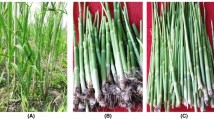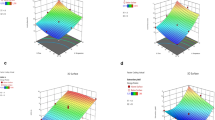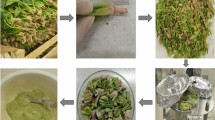Abstract
In this study, the main chemical composition, the total phenolic content (TPC), the total flavonoid content (TFC), the total anthocyanin content (TAC) and antioxidant activity (TAA) of blackthorn (Prunus spinosa L.) fruit growing wild in Edirne province were determined. Furthermore, the phenolic compounds composition was investigated by liquid chromatography–tandem mass spectrometry (LC–MS/MS) and the mineral composition was performed by inductively coupled plasma mass spectrometry (ICP-MS). In addition, the aim of the study was to investigate the effects of temperature (20–40 °C), time (2–6 min) and amplitude (20–60%) on TPC, TFC, TAC, and TAA of blackthorn during ultrasound-assisted extraction. Response surface methodology using central composite design was used to determine the optimum conditions in ultrasound-assisted extraction of bioactive compounds in blackthorn. The optimum extraction conditions were obtained with temperature 40 °C, time 3.592 min, and amplitude of 33.189%. TPC, TFC, TAC, and TAA of blackthorn were found as 3203.31 ± 4.63 mg GAE kg−1 FW, 727.41 ± 4.63 CE kg−1 FW, 135.09 ± 0.33 mg cy-3-glu kg−1 FW, and 19.65 ± 0.06 mmol TE kg−1 FW, respectively, which were consistent with predicted values. The ultrasound-assisted extraction can be considered as an efficient green and practical technique for the recovery of bioactive compounds in blackthorn.


Similar content being viewed by others
Data availability
The data was obtained during Research Projects supported by Trakya University (TUBAP, Grant No.: 2020/144). The authors declare that the data supporting the findings of this study are available within the article files and if necessary, the data files can be presented by the corresponding author.
References
I. Popescu, G. Caudullo, Prunus spinosa in Europe: distribution, habitat, usage and threats. U: European Atlas of Forest Tree Species,(San-Miguel-Ayanz, J., de Rigo, D., Caudullo, G., Houston Durrant, T., Mauri, A. ured.), Luxembourg, str, 2016. 145.
T. Özcan, Some vitamin and organic acid contents in the fruits of Prunus spinosa L. subsp. dasyphylla (Schur) Domin from Europe-in-Turkey. Eur. J. Biol. 67(2), 105–114 (2008)
D. Fraternale et al., Prunus spinosa fresh fruit juice: antioxidant activity in cell-free and cellular systems. Nat. Prod. Commun. 4(12), 1934578X0900401211 (2009)
Veličković, J.M., et al., Phenolic composition, antioxidant and antimicrobial activity of the extracts from Prunus spinosa L. fruit. Hemijska industrija, 2014. 68(3): p. 297–303.
Marchelak, A., et al., Bioactivity potential of Prunus spinosa L. flower extracts: Phytochemical profiling, cellular safety, pro-inflammatory enzymes inhibition and protective effects against oxidative stress in vitro. Frontiers in pharmacology, 2017. 8: p. 680.
Karakas, N., et al., Antioxidant activity of blackthorn (Prunus spinosa L) fruit extract and cytotoxic effects on various cancer cell lines. Medeniyet Medical Journal, 2019. 34(3): p. 297.
L. Barros et al., Strawberry-tree, blackthorn and rose fruits: detailed characterisation in nutrients and phytochemicals with antioxidant properties. Food Chem. 120(1), 247–254 (2010)
B.M. Popović et al., Exploring fruits from genus Prunus as a source of potential pharmaceutical agents–In vitro and in silico study. Food Chem. 358, 129812 (2021)
A. Magiera et al., Polyphenol-enriched extracts of Prunus spinosa fruits: anti-inflammatory and antioxidant effects in human immune cells ex vivo in relation to phytochemical profile. Molecules 27(5), 1691 (2022)
M. Chen, Y. Zhao, S. Yu, Optimisation of ultrasonic-assisted extraction of phenolic compounds, antioxidants, and anthocyanins from sugar beet molasses. Food Chem. 172, 543–550 (2015)
F. Chemat, M.K. Khan, Applications of ultrasound in food technology: processing, preservation and extraction. Ultrason. Sonochem. 18(4), 813–835 (2011)
M.G. Leichtweis et al., Ultrasound as a rapid and low-cost extraction procedure to obtain anthocyanin-based colorants from Prunus spinosa L. fruit epicarp: comparative study with conventional heat-based extraction. Molecules 24(3), 573 (2019)
L.G. D’Alessandro et al., Kinetics of ultrasound assisted extraction of anthocyanins from Aronia melanocarpa (black chokeberry) wastes. Chem. Eng. Res. Des. 92(10), 1818–1826 (2014)
E. Espada-Bellido et al., Optimization of the ultrasound-assisted extraction of anthocyanins and total phenolic compounds in mulberry (Morus nigra) pulp. Food Chem. 219, 23–32 (2017)
N. Masuzawa, E. Ohdaira, M. Ide, Effects of ultrasonic irradiation on phenolic compounds in wine. Jpn. J. Appl. Phys. 39(5S), 2978 (2000)
B. Tiwari et al., Stability of anthocyanins and ascorbic acid in sonicated strawberry juice during storage. Eur. Food Res. Technol. 228(5), 717–724 (2009)
T. Türken, H.S. Erge, Effect of ultrasound on some chemical and microbiological properties of sour cherry juice by response surface methodology. Food Sci. Technol. Int. 23(6), 540–549 (2017)
Y. Ma et al., Ultrasound-assisted extraction of hesperidin from Penggan (Citrus reticulata) peel. Ultrason. Sonochem. 15(3), 227–232 (2008)
F. Shahidi et al., Nutrient distribution and phenolic antioxidants in air-classified fractions of beach pea (Lathyrus maritimus L.). J. Agric. Food Chem. 49(2), 926–933 (2001)
V. Dewanto et al., Thermal processing enhances the nutritional value of tomatoes by increasing total antioxidant activity. J. Agric. Food Chem. 50(10), 3010–3014 (2002)
Giusti, M.M. and R.E. Wrolstad, Characterization and measurement of anthocyanins by UV‐visible spectroscopy. Current Protocols Food Analytical Chemistry, 2001(1): p. F1. 2.1-F1. 2.13.
R. Re et al., Antioxidant activity applying an improved ABTS radical cation decolorization assay. Free Radical Biol. Med. 26(9–10), 1231–1237 (1999)
N.E. Bayram et al., Macronutrient and micronutrient levels and phenolic compound characteristics of monofloral honey samples. J. Food Nutr. Res. 59(4), 211–322 (2020)
R. Ganhao et al., Characterization of selected wild Mediterranean fruits and comparative efficacy as inhibitors of oxidative reactions in emulsified raw pork burger patties. J. Agric. Food Chem. 58(15), 8854–8861 (2010)
T. Marakoğlu et al., Proximate composition and technological properties of fresh blackthorn (Prunus spinosa L. subsp dasyphylla (Schur)) fruits. J. Food Eng. 68(2), 137–142 (2005)
S. Cosmulescu, I. Trandafir, V. Nour, Phenolic acids and flavonoids profiles of extracts from edible wild fruits and their antioxidant properties. Int. J. Food Prop. 20(12), 3124–3134 (2017)
E. Sikora, M.I. Bieniek, B. Borczak, Composition and antioxidant properties of fresh and frozen stored blackthorn fruits (Prunus spinosa L.). Acta Sci. Pol. Technol. Aliment. 12(4), 365–372 (2013)
I. Egea et al., Six edible wild fruits as potential antioxidant additives or nutritional supplements. Plant Foods Hum. Nutr. 65(2), 121–129 (2010)
V. Dragović-Uzelac et al., Total phenolics and antioxidant capacity assays of selected fruits. Agric. Conspec. Sci. 72(4), 279–284 (2007)
F. Celik et al., Determination of phenolic compounds, antioxidant capacity and organic acids contents of Prunus domestica L., Prunus cerasifera Ehrh. and Prunus. spinosa L. fruits by HPLC. Acta Chromatogr. 29(4), 507–510 (2017)
B.M. Ruiz-Rodríguez et al., Wild blackthorn (Prunus spinosa L.) and hawthorn (Crataegus monogyna Jacq.) fruits as valuable sources of antioxidants. Fruits 69(1), 61–73 (2014)
B.A. Acosta-Estrada, J.A. Gutiérrez-Uribe, S.O. Serna-Saldívar, Bound phenolics in foods, a review. Food Chem. 152, 46–55 (2014)
S.F. Tan et al., Ultrasonic emulsification of parenteral valproic acid-loaded nanoemulsion with response surface methodology and evaluation of its stability. Ultrason. Sonochem. 29, 299–308 (2016)
O. Yemiş, G. Mazza, Optimization of furfural and 5-hydroxymethylfurfural production from wheat straw by a microwave-assisted process. Biores. Technol. 109, 215–223 (2012)
Z. Zeković et al., Optimization of microwave-assisted extraction (MAE) of coriander phenolic antioxidants–response surface methodology approach. J. Sci. Food Agric. 96(13), 4613–4622 (2016)
J. Ivanovic et al., Antioxidant properties of the anthocyanin-containing ultrasonic extract from blackberry cultivar “Čačanska Bestrna.” Ind. Crops Prod. 53, 274–281 (2014)
E. Dorta, M.G. Lobo, M. Gonzalez, Reutilization of mango byproducts: study of the effect of extraction solvent and temperature on their antioxidant properties. J. Food Sci. 77(1), C80–C88 (2012)
W. Tchabo et al., Ultrasound-assisted enzymatic extraction (UAEE) of phytochemical compounds from mulberry (Morus nigra) must and optimization study using response surface methodology. Ind. Crops Prod. 63, 214–225 (2015)
K. Lukić et al., Effects of high power ultrasound treatments on the phenolic, chromatic and aroma composition of young and aged red wine. Ultrason. Sonochem. 59, 104725 (2019)
M. Alothman, R. Bhat, A. Karim, Antioxidant capacity and phenolic content of selected tropical fruits from Malaysia, extracted with different solvents. Food Chem. 115(3), 785–788 (2009)
Y.P. Lim et al., Correlation between the extraction yield of mangiferin to the antioxidant activity, total phenolic and total flavonoid content of Phaleria macrocarpa fruits. J. Appl. Res. Med. Arom. Plants 14, 100224 (2019)
A. Patras et al., Effect of thermal processing on anthocyanin stability in foods; mechanisms and kinetics of degradation. Trends Food Sci. Technol. 21(1), 3–11 (2010)
Acknowledgements
This research was supported by Trakya University Office of Scientific Research Projects Coordinations (TUBAP, Grant No.: 2020/144).
Author information
Authors and Affiliations
Contributions
All authors contributed at these stages including formal analysis; investigation; writing-original draft; writing-review & editing.
Corresponding author
Ethics declarations
Conflict of interest
The author(s) declared no potential conflicts of interest with respect to the research, authorship, and/or publication of this article.
Additional information
Publisher's Note
Springer Nature remains neutral with regard to jurisdictional claims in published maps and institutional affiliations.
Rights and permissions
Springer Nature or its licensor (e.g. a society or other partner) holds exclusive rights to this article under a publishing agreement with the author(s) or other rightsholder(s); author self-archiving of the accepted manuscript version of this article is solely governed by the terms of such publishing agreement and applicable law.
About this article
Cite this article
Damar, I., Yilmaz, E. Ultrasound-assisted extraction of phenolic compounds in blackthorn (Prunus spinosa L.): characterization, antioxidant activity and optimization by response surface methodology. Food Measure 17, 1467–1479 (2023). https://doi.org/10.1007/s11694-022-01723-5
Received:
Accepted:
Published:
Issue Date:
DOI: https://doi.org/10.1007/s11694-022-01723-5




